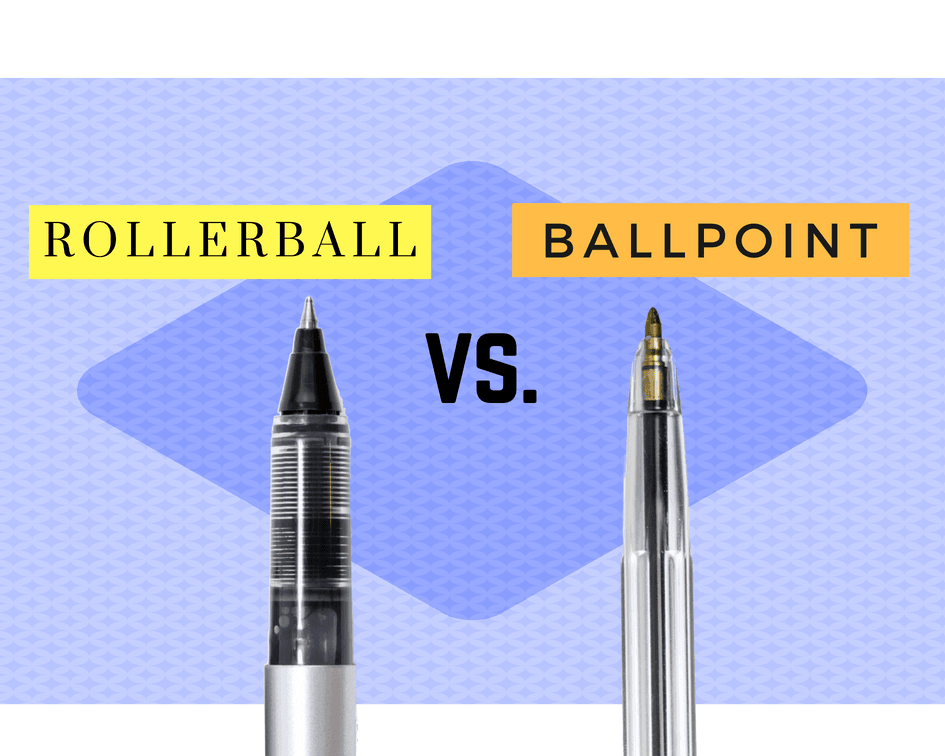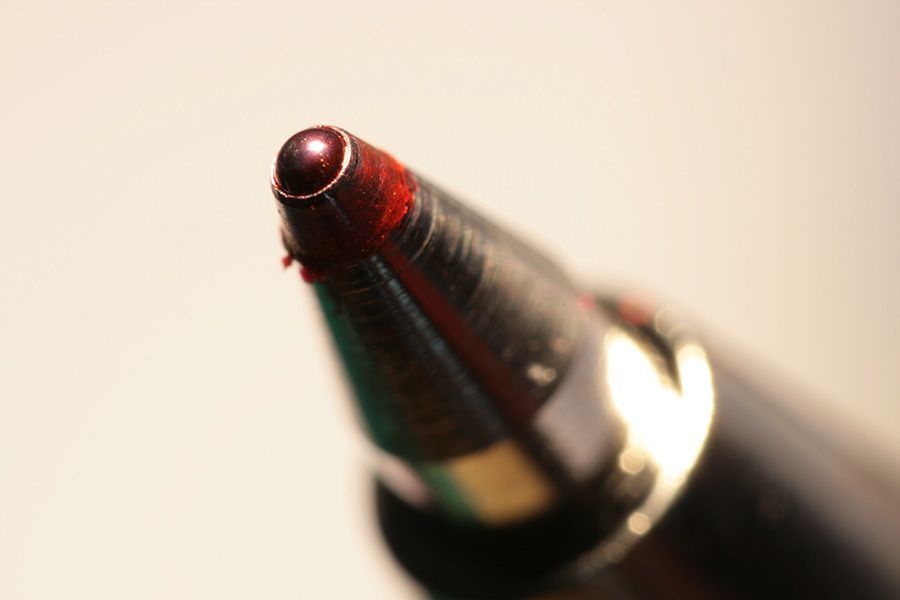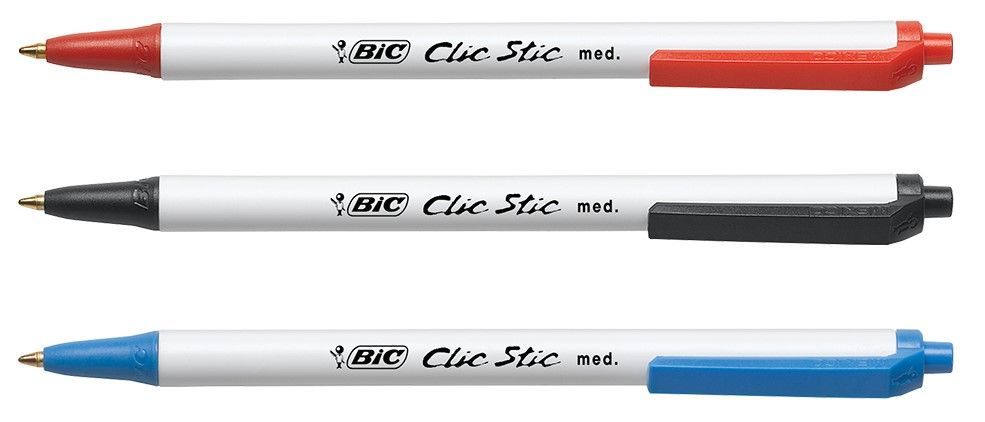Even if you don’t often write by hand, there will be times when you’ll need to jot something down quickly. When that moment occurs, which type of pen will you choose? The most common choices on the shelves today are rollerball pens and ballpoint pens.
The main difference between the rollerball pen and the ballpoint pen is the ink, which varies from thin inks to thick inks. The rollerball pen uses the thinner water-based ink, which takes longer to dry. Water-based ink is consumed more easily but allows for more vibrant and expressive writing. The ballpoint pen uses an oil-based ink, which is considered thick and sticky. This thicker ink dries faster, lasts longer, can write across most surfaces, and creates a more precise, but duller-looking line.Types of Pens
*Note: Mobile devices - scroll right to see entire table.
Pen Type | Ink Type | How does it work? | Ink Dry Time |
|---|---|---|---|
Rollerball Pen | Water or gel-based | A ballpoint pen designed to use water or gel-based ink | Water-based ink dries the slowest of all inks. Gel inks dry faster than water-based ink. |
Ballpoint Pen | Oil-based | Ink flows from inside around a metal ball at the tip of the pen | Oil-based ink dries faster than all inks. |
Fountain Pen | Water-based | Ink flows from a reservoir inside of the pen to the nib | Water-based ink dries the slowest. |
Gel Pen | Gel ink | Uses gel ink which is a combination of permanent oil-based ink and smooth writing of water-based ink | Gel ink, with its combination of water-based and oil-based in properties, dries slower than oil-based but faster than water-based. |
Rollerball vs. Ballpoint
The rollerball pen combines the best attributes of both the fountain pen and the ballpoint pen. A rollerball can write as smoothly as a fountain pen with all the conveniences of a ballpoint pen. The ballpoint pen is an inexpensive writing instrument whose oil-based ink lasts longer than the water-based ink in fountain pens and rollerball pens. Rollerball and ballpoint pens are similar in shape and design, except that the water-based or gel-based ink in rollerball pens allows for smoother writing experiences.
Price Difference
While the price difference between mass-produced and luxury pens varies, basic models of rollerball pens are minimally more expensive than ballpoint pens. The cheapest rollerball pens start at about $1-3 per pen, and ballpoints often cost less than $1. Both rollerball pens and ballpoint pens are available in multipacks or in bulk, which are offered at a discount and come in a variety of colors.
Uniball Vision Rollerball Pen, Source: Uniball-na.com
Uni-ball and Pilot offer a reasonable range of rollerball pens that come with water-based or gel ink in a good selection of colors and tip point sizes. BIC, Pentel, and Pilot have built their reputations on providing cheap quality ballpoint pens starting at less than $1 per pen, with the more sophisticated models ranging between $5-10. Overall, Uni-ball offers the most affordable rollerball pens on the market, and BIC manufactures the cheapest ballpoint pens.
There are luxury models of both the rollerball pen and the ballpoint pen that vary in price as well, but the luxury rollerball pens tend to be less expensive than the luxury ballpoint pens. Parker, LAMY, and Montblanc produce mid-range to luxury rollerball pens that range from $10 per pen to $100 per pen. Parker and LAMY also offer a combination of economical and luxury ballpoint pens as well that range from about $15 to over $400.Cost Over Time
The cheaper options for both rollerball and ballpoint pens come in a disposable form, but many manufacturers offer refillable options. The only investment needed in rollerball pens and ballpoint pens are the ink refills they require. Parker provides rollerball refills starting at $2-3 per refill, and their ballpoint refills start at $1. LAMY’s rollerball refills range from $7-10, and their ballpoint refills are about $5 per cartridge. Montblanc’s rollerball refills are the most expensive, at about $10 per unit.
In some cases, the refills for the cheaper rollerball and ballpoint models are available in bulk, which will make them less expensive per cartridge. Companies such as BIC, Pilot, and Pentel sell their refills for less than $1 a piece, making them the most economical option for refills.
Environmental Impact
Choosing a refillable option for both rollerball and ballpoint pens is better for the environment. Disposable models are thrown away after only one use. Using refill ink cartridges produces less waste because only the cartridge itself is discarded, as opposed to the whole pen.
Wear on Physical Body/Health
There is a difference in the writing experience between the rollerball and the ballpoint pen. The rollerball’s liquid ink flows more freely, requiring less pressure to write smoothly across the page. The ballpoint pen needs pressure to make the oil-based ink flow to the metal tip, so this can lead to hand fatigue and soreness in the fingers.
Leakage
Neither rollerball pens nor ballpoint pens are known for leaking. However, if a leak does occur, the ink in the rollerball pen is less viscous, which would cause the ink to come out of the pen more quickly than the thicker ink of a ballpoint pen.
Personal Preference
There is an ongoing debate over which pen is better: the rollerball or the ballpoint. Some users appreciate the fluidity of the rollerball’s writing, while others prefer the ballpoint pen because the thicker ink takes less time to dry. Left-handed writers tend to smudge their work with the movement of their hand across the page, so a ballpoint pen is more useful to them. The ink of a rollerball also looks more vibrant on the page because of the higher concentration of pigments, whereas the ballpoint produces a duller-looking line.
Writing
Rollerball pens are better for those who write for longer periods of time because they don’t require as much pressure on the tip to make the ink flow. Ballpoint pens are better for those who need a reliable writing instrument for quick note or list-making, or a signature.
Bleeding Through Paper
The thinner water-based ink of the rollerball is more likely to cause bleed-throughs on low-quality paper. The paper fibers absorb more of the ink, which will comes through on the other side of the page. Oil-based ink in ballpoints doesn’t soak into the paper fibers, creating the illusion that it is “floating” on top of the paper. The decreased absorption rate into the paper fibers decreases bleedthroughs on paper of any quality.
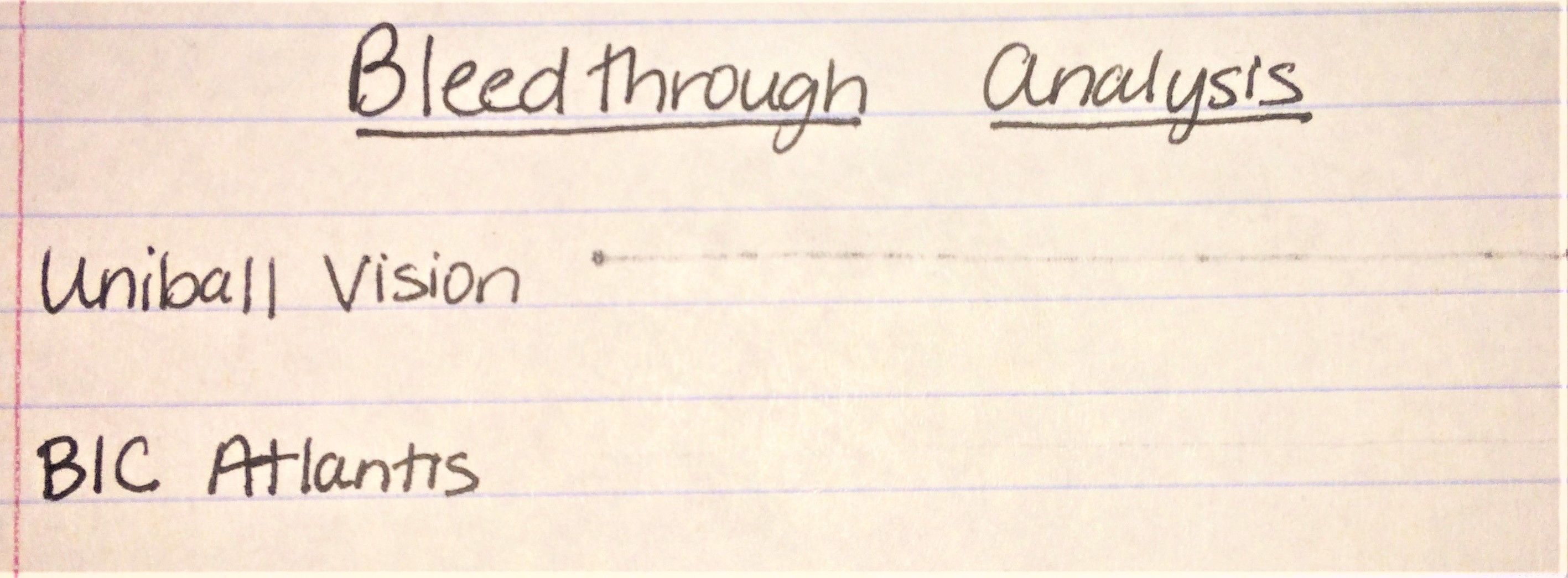
Bleedthrough Analysis of a rollerball pen and a ballpoint pen. The examples are the Uniball Vision rollerball pen and the BIC Atlantis ballpoint pen (self-sourced)
Convenience
Most users do not see a difference in the convenience of a rollerball pen and a ballpoint pen. Both come in disposable or refillable models, and their ink refills are easily accessible. There are no special steps the writer needs to take to replace the ink cartridge: they usually pop right into the barrel of the pen.
Both pens are convenient for travel, but it is always best to travel with a rollerball pen that has either a completely full or completely empty ink cartridge. If a leak occurs due to the pressure changes in the atmosphere while in flight, the water-based ink in a rollerball pen will cause more of a mess. Ballpoints are not known for leaking at high altitudes.
What is a Rollerball pen?

The rollerball pen is a versatile writing instrument that combines the best attributes of both the fountain pen and the ballpoint pen. A rollerball can write as smoothly as a fountain pen with all the conveniences of a ballpoint pen. Rollerball inks can vary, but the core types are water-based ink in either liquid or gel form. Rollerball pens can be either disposable or refillable, and they are more convenient in travel.
Who invented the Rollerball pen?
Rollerball pen history begins in 1963, when Ohto, a Japanese manufacturing company, became the first manufacturer of the distinctive pen. Founded in 1929, Ohto was primarily an ink and dye company that spent research and development innovating upon the ballpoint pen. Using a water-based ink that offered a smoother writing experience than oil-based ink, the rollerball pen emerged as the leak-free alternative to the fountain pen by the mid-1970s. Since then, Ohto has improved upon their initial design, creating a waterproof and fade-proof rollerball pen in 1991.
Parts of the Rollerball Pen
Like the fountain pen, the rollerball has an internal ink reservoir of water-based ink that flows through a feed to the tip of the pen. Many users notice that most rollerball pen models, the Pilot models, in particular, have a transparent section in the grip with ridges on the inside. These ridges create the feed, the part of the rollerball that is most similar to a fountain pen. The feed connects to the ink cartridge, regulating the flow of ink to the tip, or roller ball, of the pen.
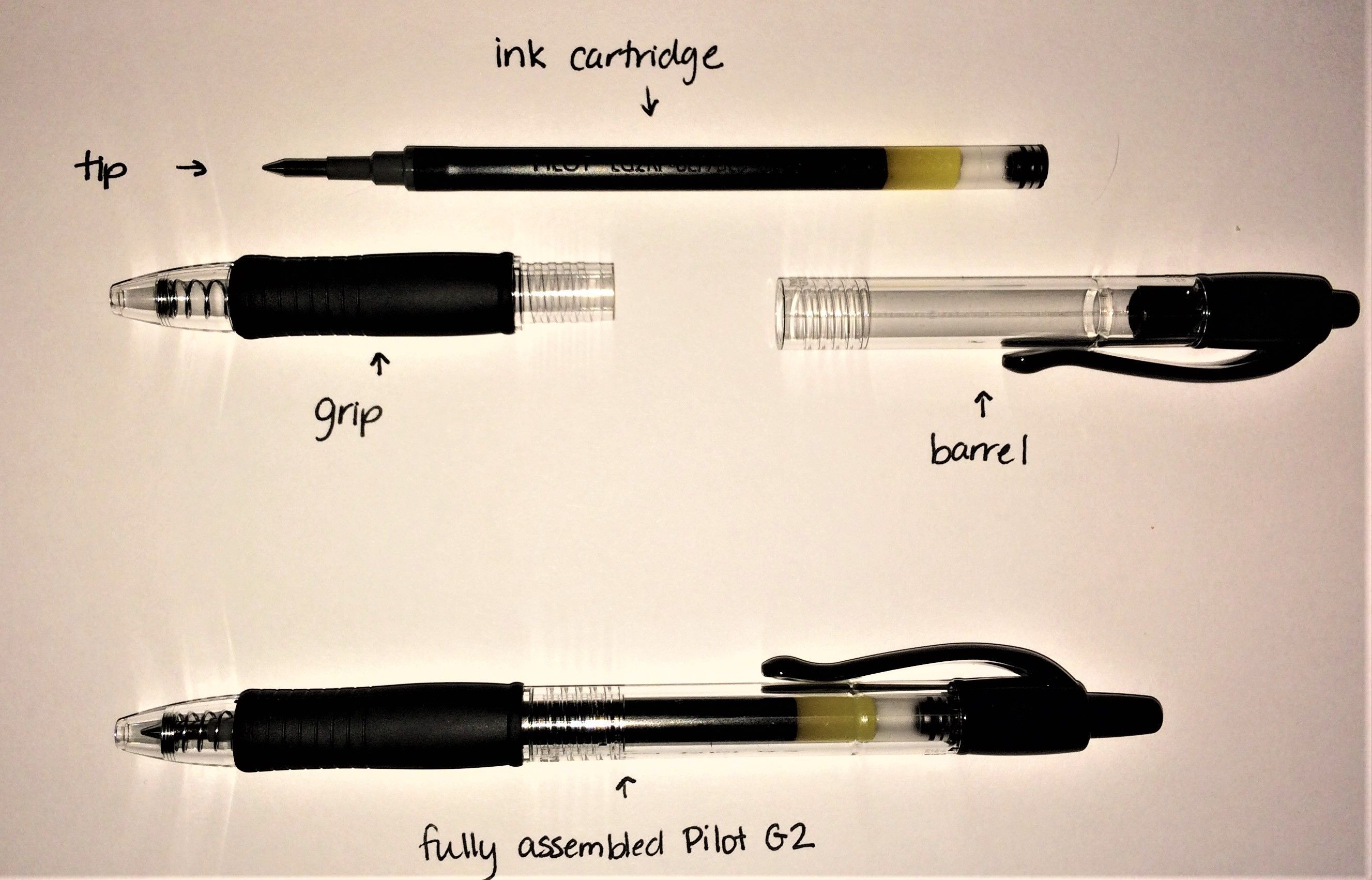
A labeled diagram of a Pilot G2 rollerball pen (cap, barrel, tip, feed, ink cartridge). (Photograph courtesy of the author)
Note: Rollerball pens come in many designs, and the anatomy of one will not necessary look like another. The most important basic parts of a rollerball pen are the cap, the barrel, the tip, the feed, and the ink cartridge.
The rollerball pen has the same fundamental mechanisms of the ballpoint pen, except for the feed system, a marked distinction from its predecessor. Inside the nib at the tip is a small metal ball that typically measures 0.5mm to 0.7mm in diameter. The ball in the rollerball pen is generally smaller than the ball in the ballpoint pen, which usually measures 0.7mm to 1.0mm. As the ink flows through the feed around the ball, it delivers the ink to the paper via a rolling motion like the ballpoint pen.
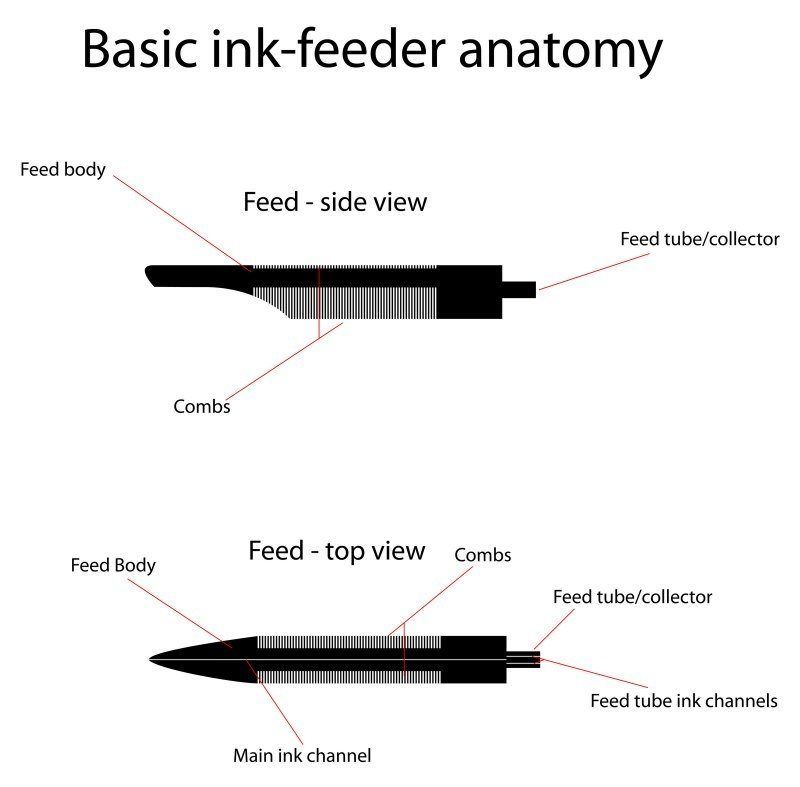
A diagram of the feed of a rollerball pen. The example in this diagram is a Pilot V5, but it shows the ridges inside the grip that control ink flow. Source: Quora
The tip houses a small metal ball that transfers ink to the page by rolling over the paper’s surface, providing a smooth, effortless experience similar to that of a fountain pen. There are two barrels within the pen that protect the ink reservoir and the internal components. Barrel couplers are rings with visible grooves on the grip that fasten the tip and the feed to the barrel of the pen as well as connect the barrel to the cap. Although most rollerball pens are non-retractable, a threaded insert and a spring prevent the ink refill from sliding around in the barrel of the pen while writing. The centerband, clip, and finial are ornamental elements that can be plated, providing convenient real estate for custom engraving.
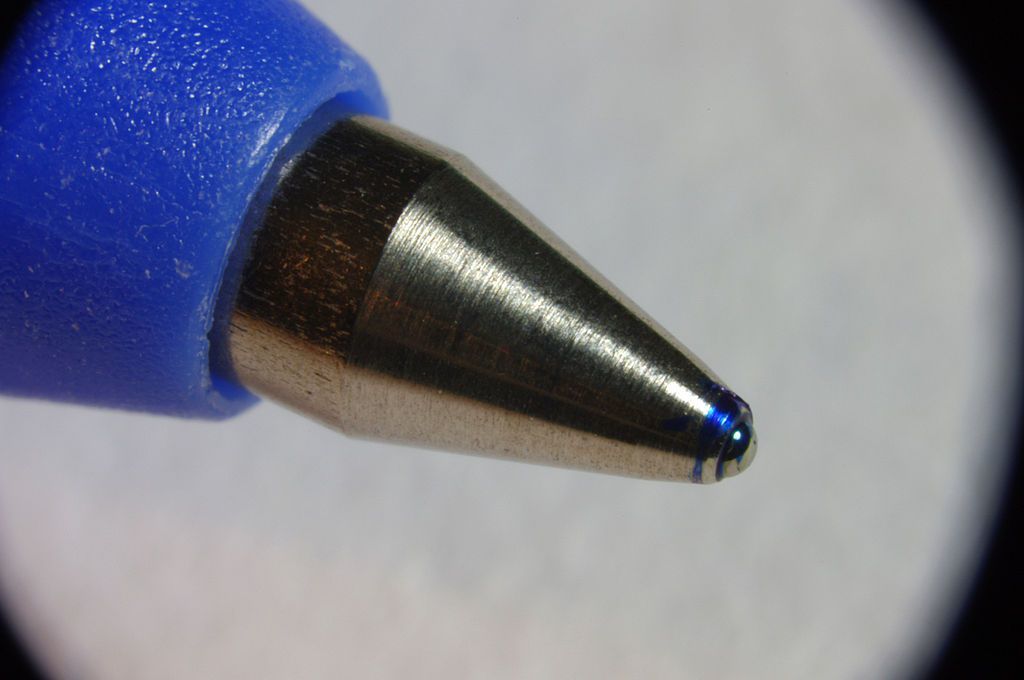
Christian Fischer, BallPenTip, CC BY-SA 3.0
The water-based ink used in the rollerball pen comes in liquid and gel consistencies. Liquid water-based ink most closely replicates writing with a fountain pen because it requires less pressure to create free-flowing writing with minimal skipping. However, a rollerball pen deposits at least three times more ink on the page than a ballpoint pen, which requires replacing the ink cartridge in refillable models more often.
Thin liquid water-based ink takes longer to dry, giving the text the same wet appearance as writing with a fountain pen. This wetness can lead to smearing if the ink isn't given sufficient time to dry, especially with left-handed writers or right-handed writers using right-to-left motion, such as in Arabic, Asian, and Hebrew script. When using a liquid ink rollerball pen on higher-quality paper with heavier weight, the ink soaks into the paper fibers with greater width and depth. This speeds up the drying time and giving it the sought-after calligraphy style.
Rollerball pens have caps to keep the ink from drying out. Water-based gel ink is more viscous than its liquid counterpart, therefore making it more prone to inconsistent writing (i.e., gaps in between lettering). However, thicker gel ink means faster drying time. Gel inks also provide a greater variety of colors not found in liquid ink.
How to Refill a Rollerball Pen
Like ballpoint pens, rollerball pens come in both disposable and refillable models. As a general rule, rollerball pens that come with a cap are refillable and those that do not are disposable. Several pen manufacturers have transitioned into making all rollerball models refillable to prevent waste, and they sell refills for their pens. Many of these manufacturers will sell a “value-pack” for their refillable pens that include the pen itself and one or more ink cartridge refills.
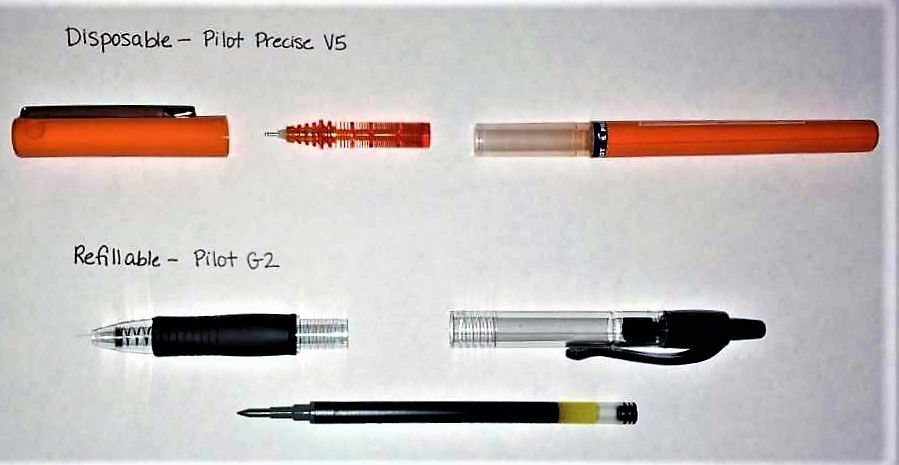
A comparison of a disposable and refillable rollerball pen side by side. (photograph courtesy of the author)
The most common refill method for the rollerball pen is to replace the empty ink cartridge with a new refill. Most manufacturers will sell ink refills separately, and a generic brand will often be compatible regardless of the brand of pen. When choosing a refill, many select a cartridge based on the color or the consistency of the ink. When using a cartridge that is not explicitly made for the type of pen in use, measuring the length of the barrel of the rollerball pen can assist in choosing the refill that is the right size. If you find that the ink refill is too short to be held in place by only the spring, an additional piece of tubing can fill the gap. Likewise, if the ink refill is too long, then you can trim the end of the refill until it fits perfectly.
A few models of rollerball pens are specially engineered to use fountain pen ink. The J. Herbin Refillable Rollerball Pen and the Rosetta Magellan Ink Cartridge Rollerball Pen use standard international short fountain pen ink cartridges or a proprietary converter. The Noodler’s Konrad Refillable Rollerball Pen uses a converter to refill the ink reservoir with bottled fountain pen ink.
Why Use a Rollerball Pen?
While the decision to use a rollerball pen comes down to personal preference, there are many benefits to using a rollerball pen. Less pressure is required to make the ink flow, so the likelihood of developing hand cramps is less likely. The water-based ink flows more freely on the page and looks more vibrant than oil-based ink. They are just as convenient as the ballpoint pen, with a variety of models and colors. When using a refillable design, the ink cartridges are widely available in a variety of online and on-site stores.
Rollerball Pen: Pros and Cons
Pros
Cons
What is a Ballpoint Pen?
Perhaps the most popular writing instrument available today, the ballpoint pen uses oil-based ink that dries faster and smears less than other inks. Pressure on the metal tip (or ball point) induces ink flow from the cartridge, coating the ball. The tip rotates when the pen is in use, transferring the ink to the paper. Mass-produced ballpoint pens are made mostly of plastic with a small amount of metal to keep costs low. Higher-end ballpoint pens are made of metal, especially the twist pens that require a metal mechanism to reveal the tip.
Who Invented the Ballpoint Pen?
In 1888, a tanner named John Loud invented a pen that would work for writing on his leather creations. His design didn’t catch on because his ballpoint pen overlooked the needs of the average consumer. Loud’s design only wrote on leather and unfortunately, it couldn’t accommodate paper. Although the ballpoint pen served the tanner’s purposes, it left a demand in writing instrument history still unfulfilled.
Fifty years later, László Bíró innovated upon Loud’s invention. A journalist motivated to overcome the obstacles with his daily use of a fountain pen, Bíró and his brother György, an engineer, formulated a viscous oil-based ink that dried quicker than water-based inks. The ballpoint pen was designed with an internal ink refill, unlike the messy and time-consuming refilling process of fountain pens of the time.
Unlike the fountain pen, the ballpoint pen didn’t leak at high-altitudes. It was because of this discovery that the Bíró brothers signed a contract to supply their new pen to pilots in the British Royal Airforce during World War II. After the war, Bíró and his brother sold the patent to to French manufacturer Marcel Bich. As the main product in his newly-formed company BIC, the ballpoint pen became commercially available through mass production. BIC is one of the most famous pen manufacturers today, well-known for their wide variety of disposable and refillable ballpoint pens and other disposable products, such as lighters and razors.
Parts of the Ballpoint Pen
There are three designs of ballpoint pens: the stick pen, the retractable pen, and the twist pen.
Ballpoint Pen Designs
How Does the Ballpoint Pen Work?
The tip is a metal rotating ball held in a socket directly below the ink cartridge. The ball spins with a 360-degree range of motion that coats the ball with ink and delivers it to the paper with the pressure of the written stroke. This constant contact between the metal ball and the ink cartridge ensures that the ink in the cartridge does not dry out and that there is always a supply of oil-based ink to coat the ball.
The disposable ballpoint pen offered a simpler alternative to the fountain pen and the dip pen. Fountain pens regularly required cleaning and refilling of the ink reservoir and the dip pen relied on dipping the tip of the nib in bottled ink to refreshing the ink supply. Although the oil-based ink is less likely to dry out, ballpoint pens can collect paper fibers at the tip that combine with the ink. This gooey substance leads to dried ink clots that will transfer to the page, but it can be easily wiped away using a moist paper towel.
The technology that makes the ballpoint pen so easy to use can also have negative effects on the hands. When using a ballpoint pen, the writer needs to apply more pressure to the tip to make the ink transfer to the writing surface. Everyone who has used a ballpoint pen understands “writer’s cramp,” the tension and pain in the hand and fingers after writing after a long period of time. “Writer’s cramp” is a medical condition called ballpoint pen tenosynovitis, which is a precursor to Carpal Tunnel Syndrome. With extended use of a ballpoint pen, ballpoint pen tenosynovitis develops into Carpal Tunnel, resulting in pain that requires therapeutic and surgical intervention.
How to fix a Ballpoint Pen that Skips
- Could be caused by dried ink on nib
- Easy tip:
- dip the ball point in rubbing alcohol to remove dried ink
- briefly heat up the ball point with a lighter
- wipe dried ink away with a slightly moistened paper towel and test the ink flow
How to refill a ballpoint pen:
The ballpoint pen was manufactured to be a disposable and convenient writing utensil. In the years since mass production, manufacturers have recognized the role that disposable ballpoint pens have on the environment. Many consumers throw away their ballpoint pens, even the refillable models, after the ink runs out, increasing the amount of plastic waste that ends up in landfills all over the world. Disposable ballpoint pens are still available: the cheapest brands are disposable, while the more expensive options are refillable.
A new consciousness of their effect on the environment has prompted ballpoint pen companies to offer refillable options for their pens. Ballpoint pen manufacturers have adopted recycling programs, and they actively label their packages as refillable models. Using refillable ballpoint pens ensures that only the empty cartridge is thrown away, which decreases the amount of waste associated with using the ballpoint pen. Like rollerball pens, some refillable ballpoint pens come with at least one extra ink refill.
Ballpoint Pen: Pros and Cons
Pros
Cons
Rollerball vs. Ballpoint pens: Which Pen is Best for You?
When selecting a pen for your needs, your decision relies on a variety of factors, such as the type of writing, the writing style, hand dominance, personal preference, and budget.
Rollerball
ballpoint
Like most people, I have used both rollerball and ballpoint pens, considering they are some of the cheapest options for writing utensils. As a writer, I always have at least one pen on me at all times, with a collection usually accumulating on my desk, in my living room, the bottom of my purse, etc. When I decided to test which pen I preferred better, I found that my activity largely affected my choice.
I am what you could call a “long-distance writer,” which means that I will sit at my desk and write for hours on end rather than type at my computer. Some may call me a Luddite, but the experience of writing is why I became a writer. I write out my projects before I type them, and I always hand-edit my work. This is a personal preference, but it makes me a better writer. When I compared the rollerball to the ballpoint, I used the Uniball Vision and the BIC Atlantis.
Comparison image of the Uniball Vision and the BIC Atlantis. (Photograph courtesy of the author.)
I found that the rollerball worked better on my drafts, and the ballpoint worked better for revisions. For years, I had been using my trusty BIC Atlantis, and I often had to make lengthy pauses in between my marathon writing due to hand cramps. Even though the BIC Atlantis fits comfortably into my hand and has a soft grip to save my fingers, I still felt pain in my hands every day. After using the Uniball Vision, I noticed that my hands didn’t hurt as badly at the end of the day.
After using ballpoint pens for years, my writing style had become one with much force and pressure. I didn’t have to do that with the rollerball pen. The water-based ink did take some time to dry, but the glide across the page helped my writing immensely. I discovered that I was pressing down less, giving me more time to write without having to stop to rest my hands. Considering that most of the writing that I do is in long stretches, I have decided to change my priority pen to the rollerball. Although I am not abandoning my BIC, I am sure that my hands will thank me.
Sources
Please comment and share below
Although this article is comprehensive, the information presented is only as accurate the material we were able to source, and is by no means exhaustive, authoritative, nor complete. If you have additions or corrections which you believe should be included in this page, we invite you to include your comments below. Please consider sharing both the citation as well as the new information with us. Our goal is to foster an open dialogue with our readers.
Please also share the article with rollerball pen or ballpoint pen enthusiasts. We appreciate you spreading the word!

